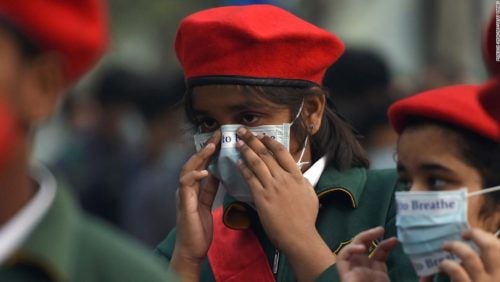Air Quality Information: Protecting Children from Air Pollution
May 16, 2019 by Marly Mentor

How is air pollution affecting children and what measures can we take to protect them?
Studies have shown that children are vulnerable to air pollution. It is important to know how air pollution impacts children and how we can limit those effects. To understand why children are susceptible to the air quality impacts, it’s important to know that children’s lungs are not fully developed. The lung surface area per kilogram of body weight are larger for children than that of adults.[1] Children breathe fifty percent more air per kilogram of body weight than adults do.[2] That is why children breathe in more air than adults, and they won’t have fully developed lungs until they reach adulthood.[3] The bronchial tree continues to develop during early childhood.[4] At birth, the number of alveoli in the human lung is 24 million.[5] By the time someone turns four, alveoli increases to 257 million.[6]
Children’s immune systems are similarly not as strong as those of adults in fighting off infections. This means that they are more likely to develop respiratory issues.[7] As a result, children’s overall health is greatly susceptible to air pollution. Children are even more vulnerable because of the resulting effect to their development. Because children also spend more time outside than adults,[8] they end up inhaling more air pollution than adults. With children who spend significant time outside, air pollution becomes much more impactful. A study conducted by the Barcelona Institute for Global Health (ISGlobal) showed that children who are exposed to air pollution have a higher risk of being overweight and obese.[9]
In the Southern California Children’s Health Study, researchers looked at children between the ages of ten and eighteen from 1993 to 2001.[10] They discovered that teenagers who live in more polluted areas have a higher risk of reduced lung growth.[11] The reduced lung growth had the same effect as growing up in a home with smokers.[12] There are evidence that when air pollution is reduced, children’s health improves.[13] In 2015, there was a follow-up study done to the Southern California Children’s Health study.[14] Researchers observed a new set of children growing up between 2007 and 2011 living in the same area as the previous study.[15] The air quality in Southern California was much cleaner in this new study.[16] In comparing children in the first study to children in the second study, researchers found that children growing up in the cleaner air environment had much better lung function.[17] Studies like this demonstrate that in order to protect children’s health, it is crucial to reduce air pollution.
Besides the growing need to reduce air pollution, there are other ways to protect children’s health from air pollution. Since children spend more time outside than adults, it is important to safeguard them from the negative impact of air pollution. Furthermore, air quality information is impactful in informing people of the different air quality levels of certain areas. The U.S. Environmental Protection Agency (EPA) has created the Air Quality Index (AQI) to enhance the reporting of daily air quality information.[18] AQI reports on how clean or unhealthy the air is and what the effects are. Air quality is constantly changing like the weather. Tools such as these could be effectively used to protect children’s health. It would allow parents to know when there are high pollution periods in order to reduce children’s outdoor activities and allow them to take advantage of the low pollution periods. Children’s susceptibility to air pollution raises the high need for better, widespread, and more in-depth air quality information.
[1] See Growth Including Reproduction and Morphological Development 346 (See Philip L. Altman & and Dorothy S. Dittmer eds., 1962).
[2] See id.
[3] Rodney Dietert et al., Workshop to Identify Critical Windows of Exposure for Children’s Health: Immune and Respiratory Systems Workgroup Summary, Environmental Health Perspectives, 2000, at 483-490.
[4] See id.
[5] See id.
[6] See id.
[7] World Health Organization, The Effects of Air Pollution on Children’s Health and Development: A Review of the Evidence 29 (2005), http://www.euro.who.int/document/E86575.pdf.
[8] American Academy of Pediatrics Committee on Environmental Health, Ambient Air Pollution: Health Hazards to Shildren. Pediatrics, https://pediatrics.aappublications.org/content/114/6/1699 (2004).
[9] Barcelona Institute for Global Health, Children Exposed to Air Pollution at School may be at Greater Risk of Overweight and Obesity, www.sciencedaily.com/releases/2019/01/190131101057.htm (Jan. 31, 2019).
[10] American Lung Association, Children and Air Pollution, https://www.lung.org/our-initiatives/healthy-air/outdoor/air-pollution/children-and-air-pollution.html (last visited May 3, 2019).
[11] Id.
[12] Id; See Olivier Laurent et al., A Statewide Nested Case–Control Study of Preterm Birth and Air Pollution by Source and Composition: California, 2001–2008, Environmental Health Perspectives, 2016, at 1479-1486.
[13] Id.
[14] Id.
[15] Id.
[16] Id.
[17] Id; See W. James Gauderman et al, The Effect of Air Pollution on Lung Development from 10 to 18 Years of Age, The New England Journal of Medicine, 2004, at 1057-1067.
[18] See AirNow, Air Quality Index (AQI) Basics, https://airnow.gov/index.cfm?action=aqibasics.aqi (last visited May 3, 2019).

